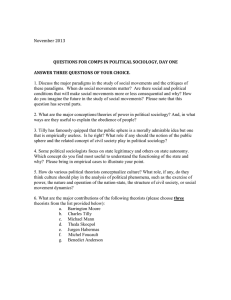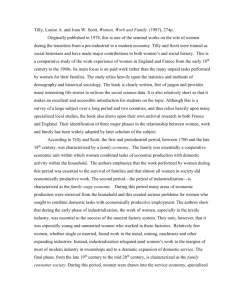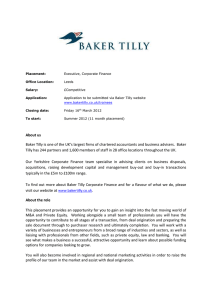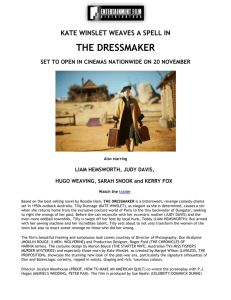Thinking About Chuck Tilly and Social Movements
advertisement
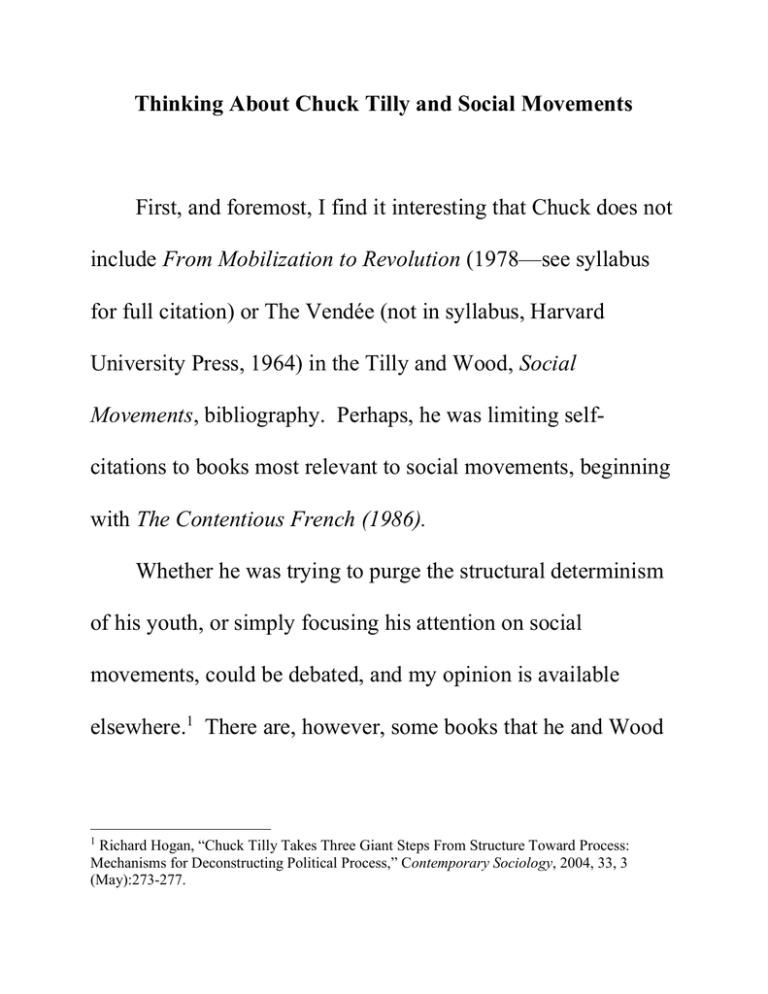
Thinking About Chuck Tilly and Social Movements First, and foremost, I find it interesting that Chuck does not include From Mobilization to Revolution (1978—see syllabus for full citation) or The Vendée (not in syllabus, Harvard University Press, 1964) in the Tilly and Wood, Social Movements, bibliography. Perhaps, he was limiting selfcitations to books most relevant to social movements, beginning with The Contentious French (1986). Whether he was trying to purge the structural determinism of his youth, or simply focusing his attention on social movements, could be debated, and my opinion is available elsewhere.1 There are, however, some books that he and Wood Richard Hogan, “Chuck Tilly Takes Three Giant Steps From Structure Toward Process: Mechanisms for Deconstructing Political Process,” Contemporary Sociology, 2004, 33, 3 (May):273-277. 1 cite that might be helpful for those who wish to go beyond the modern world, which is what we get in Social Movements. He cites Tilly (2006) Regimes and Repertoires as the best source on non-democratic or other regimes. I read the preface (I have not read the book yet), and it looks interesting for those interested in that topic—why social movements are not prevalent or effective in non-democratic regimes. Another book, from which Tilly (2006) borrows generously, is Tilly (2003), The Politics of Collective Violence (which I have read). This book is particularly useful in understanding terrorism, brawls, and other types of collective violence (pp. 14-15) that tend to decline in strong democratic states (p. 225). I strongly recommend this book, as well as his book, Democracy (2007— also in Wood and Tilly bib), where he attempts to explain why Western Europe and the U.S. were leaders in democratization. Chuck started as a student of the French counter-revolution (The Vendee [1964]), which is a revisionist critique of Marxist analyses that tend to see the peasants as “potatoes in a sack,” as Marx said in The 18th Brumaire of Louis Bonaparte). By 1975, when I first met him, Chuck was interested in the study of political struggle, more generally, particularly what we might call grassroots political challenges (contention). This was part of the “new” social science history of the Seventies, where social science theories and methods guided historical analyses. The creation of Social Science History (both association and journal) and the data archive (Inter-university Consortium for Political and Social Research [ICPSR], still at the University of Michigan) were fruits of the “new” social science history. Within the sociology department at Michigan, Tilly frequently served on dissertation committees with Bill Gamson (a pioneer in Resource Mobilization theory) and later with Jeff Paige (a Marxist who studied peasant revolution) and still later with Mayer Zald (the organizations guy who teamed up with John McCarthy to become the Social Movement Organization wing of Resource Mobilization theory). During these years (1969-1984), Social Science History and Resource Mobilization theory went from challenging established institutions to achieving institutional status. Both the “new” social science history and Resource Mobilization theory became the dominant perspectives that were challenged by the “new” Western history, state-centered and “new” social movement theories, which we will have occasion to discuss later. At this point, (Contentious French [1986]), Chuck became interested in how the form and content of contention changed, in Western Europe and the U.S., between 1500 and 2000. He had started (in 1978) looking for a theory that might guide the collection and analysis of data. In the course of gathering his data, however, even before 1978, he was already thinking about repertoire changes and changes in opportunities and threats that he treated as exogenous factors (things that were outside his conceptual model).2 Chuck supervised the collection and analysis of two huge datasets (on France and England) and cooperated with or mentored many people (including McAdam, Tarrow, and Franzosi) who gathered data on Italy and the U.S (and elsewhere). Since he was extremely well read and very much in demand, he mastered a variety of languages and literatures, including what we now might call international or global politics, even though his focus has always been on the nationstate and on the challengers and members of a national polity. 2 Tilly, Charles. 1977. “Getting it Together in Burgundy, 1675-1975.” Theory and Society 4, 4:479-504. As we shall see when you are finished with Tilly (19782008), his early work, in particular, has been subject to increasing criticism, even by him. To some extent, Tilly and his colleagues developed new theories or refined old ones in response to criticism. Tarrow, McAdam, and the team of McAdam, Tarrow, and Tilly, developed Opportunity Structures, Political Process theory, and, more recently, the Dynamics of Contention: a theory of general mechanisms and processes that seem to operate similarly across time and place. Since I tend to see more continuity than change in Tilly, 1978-2008, I am committed to developing the theory from its roots (in 1978). My research indicates that the original Resource Mobilization theory still works in guiding researchers who want to explain past events or even to predict future events or nonevents.3 At the same time, modifications over the course of thirty years have helped us to incorporate change into the model, including repertoire and regime change, and the relationship between the two. Since Chuck’s death in 2008 there has been increasing criticism of Resource Mobilization and its progeny. The most popular critique in recent years has been the assertion that it is part of the bad old structural theories: structural functionalism, Marxism, etc.4 Of course, I find this critique humorous, first, because I do not see Tilly as a structural determinist, and second, because I am a structural determinist and proud of it. 3 Richard Hogan, "Resisting Redemption: The Republican Vote in 1876 Georgia" Social Science History 2011, 35, 2:133-166. Goodwin, Jeff and James M Jasper. 1999. “Caught in a Winding, Snarling Vine: The Structural Bias of Political Process Theory.” Sociological Forum, Vol. 14, No. 1:27-54. 4
